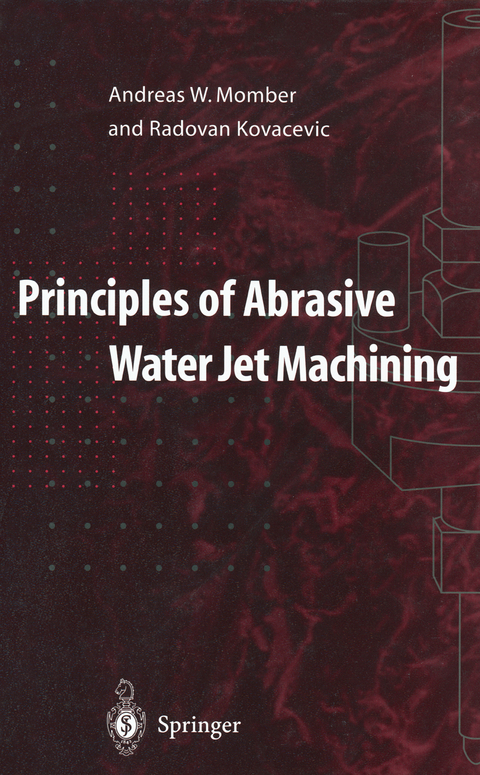
Principles of Abrasive Water Jet Machining
Springer London Ltd (Verlag)
978-1-4471-1574-8 (ISBN)
1 Introduction.- 1.2 Classification of High-Speed Fluid Jets.- 1.3 State-of-the-Art Application of the Water-Jet Technique.- 2 Classification and Characterization of Abrasive Materials.- 2.1 Classification and Properties of Abrasive Materials.- 2.2 Abrasive-Material Structure and Hardness.- 2.3 Abrasive-Particle Shape Parameters.- 2.4 Abrasive-Particle Size Distribution and Abrasive-Particle Diameter.- 2.5 Number and Kinetic Energy of Abrasive Particles.- 3 Generation of Abrasive Water Jets.- 3.1 Properties and Structure of High-Speed Water Jets.- 3.2 Abrasive Particle — Water Jet Mixing Principles in Injection Systems.- 3.3 Abrasive Suction in Injection Systems.- 3.4 Abrasive-Particle Acceleration in Injection Systems.- 3.5 Abrasive-Particle Fragmentation in Injection Systems.- 3.6 Focus Wear in Injection Systems.- 3.7 Generation of Suspension-Abrasive Water Jets.- 4 Structure and Hydrodynamics of Abrasive Water Jets.- 4.1 General Structure of Injection-Abrasive Water Jets.- 4.2 Phase Distributions in Injection-Abrasive Water Jets.- 4.3 Abrasive-Particle Velocity Distribution in Injection-Abrasive Water Jets.- 4.4 Structure of Suspension-Abrasive Water Jets.- 5 Material-Removal Mechanisms in Abrasive Water-Jet Machining.- 5.1 Erosion by Single Solid-Particle Impact.- 5.2 Micro-Mechanisms of Abrasive-Particle Material-Removal in Abrasive Water-Jet Machining.- 5.3 Material Removal by the High-Speed Water Flow.- 5.4 Macro-Mechanisms of Abrasive Water-Jet Material Removal.- 5.5 Energy Balance of Abrasive Water-Jet Material Removal.- 5.6 Erosion-Debris Generation and Acceleration.- 5.7 Damping Effects in Abrasive Water-Jet Material Removal.- 5.8 Heat Generation During Abrasive Water-Jet Material Removal.- 5.9 Target-Material Property Influence on Material Removal.- 6Modeling of Abrasive Water Jet Cutting Processes.- 6.1 Introduction.- 6.2 Volume-Displacement Models.- 6.3 Energy-Conservation Models.- 6.4 Regression Models.- 6.5 Kinetic Model of the Abrasive Water-Jet Cutting Process.- 6.6 Fuzzy Rule-Based Model of the Abrasive Water-Jet Cutting Process.- 6.7 Numerical Models.- 7 Process Parameter Optimization.- 7.1 Definition of Process and Target Parameters.- 7.2 Influence of Hydraulic Process Parameters.- 7.3 Influence of Cutting Parameters.- 7.4 Influence of Mixing Parameters.- 7.5 Influence of Abrasive Parameters.- 8 Geometry, Topography and Integrity of Abrasive Water-Jet Machined Parts.- 8.1 Cut Geometry and Structure.- 8.2 Topography of Abrasive Water-Jet Generated Surfaces.- 8.3 Integrity of Abrasive Water-Jet Generated Surfaces.- 9 Alternative Machining Operations with Abrasive Water Jet.- 9.1 Capability of Abrasive Water Jets for Alternative Machining.- 9.2 Milling with Abrasive Water Jets.- 9.3 Turning with Abrasive Water Jets.- 9.4 Piercing with Abrasive Water Jets.- 9.5 Hole Trepanning and Deep-Hole Drilling with Abrasive Water Jets.- 9.6 Polishing with Abrasive Water Jet.- 9.7 Screw-Thread Machining with Abrasive Water Jets.- 10 Control and Supervision of Abrasive Water-Jet Machining Processes.- 10.1 General Aspects of Process Control.- 10.2 Control of the Abrasive-Particle Suction Process.- 10.3 Control of Water-Orifice Condition and Wear.- 10.4 Control of Focus Condition and Wear.- 10.5 Measurement and Control of Abrasive Water-Jet Velocity.- 10.6 Measurement and Control of Abrasive Water-Jet Structure.- 10.7 Control of Material-Removal Processes.- 10.8 Control of Depth of Penetration.- 10.9 Control of the Generated Surface Topography.- 10.10 Expert Systems for Abrasive Water-Jet Machining.- References.
| Zusatzinfo | XXV, 394 p. |
|---|---|
| Verlagsort | England |
| Sprache | englisch |
| Maße | 155 x 235 mm |
| Themenwelt | Naturwissenschaften ► Physik / Astronomie ► Mechanik |
| Naturwissenschaften ► Physik / Astronomie ► Strömungsmechanik | |
| Naturwissenschaften ► Physik / Astronomie ► Thermodynamik | |
| Technik ► Maschinenbau | |
| ISBN-10 | 1-4471-1574-0 / 1447115740 |
| ISBN-13 | 978-1-4471-1574-8 / 9781447115748 |
| Zustand | Neuware |
| Haben Sie eine Frage zum Produkt? |
aus dem Bereich


